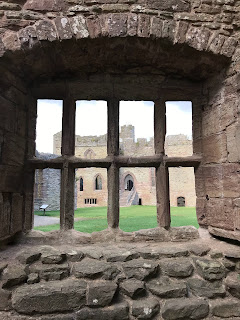We’ve just come back from a short holiday in Norfolk, a place we’ve always wanted to visit. Flat, unlike Wales. The first sign of trouble and a harbinger of things to come was the motorway. It was closed, or at least a part of it was.
Enroute, we stopped for the night at Cambridge and discovered the hotel restaurant was closed and we ended up with a Pret A Manger sandwich. Thus nourished, we walked by the side of the Cam on a scenic path.
Across the river were some of the major colleges which, seen from the back, exuded a peculiar intimacy. From the front, they merely look impressive, Trinity especially.

Trinity above. Kings below from the back
Unfortunately, like the motorway and the hotel restaurant, every college we went to showed the same sign: Closed to visitors. Fortunately the Anchor Pub was open.
Ely Cathedral
The following day we stopped off at Ely, eager to explore the Cathedral; to our horror, that too was closed for five days. A major film production, a very nice lady explained. Even The Almonry – an interesting looking tea house was closed and not a film crew in sight.
Unable to see the interior we took exterior shots from every conceivable angle and imagined what we were missing.
Oliver Cromwell’s house and information centre was not closed; there I bought three bottles of beer, a compensation Cromwell would have understood.
Our cottage – we half expected it to be closed —offered a fine sunset and an eerie walk in surrounding woods.
Along a dark and gloomy path, a sinister rustling prompted X Files unease. A weird guttural wailing sound clinched the matter, and we retreated briskly. The following day we felt a bit ashamed on hearing we’d been spooked by a Muntjac – a small stocky deer about the size of a dog.
And finally, our first real day in Norfolk. Blakeney, a truly magical place. And open. Blakeney was very open
I suddenly had boat envy
Salt marshes for as far as the eye could see
Blakeney, meaning Black Island is a fine name and a vast improvement on its earlier name of Snitterley. That in turn was a corruption of Esnuterlie recorded in the Domesday Book along with its two major landholders, Walter Gifford and William de Noyers. Snitterley to Blakeney was, in my view, a triumphant rebrand. But there it stops, its only other claim to fame being that Edward III’s wife, Queen Philippa enjoyed a fish that came from Blakeney. Other than that minor gastronomic triumph Blakeney was noted for its piratical inhabitants and its refusal to supply a ship for the battle against the Spanish Armada.
Can you see that house in the far distance? (It's easy if you try, as John Lennon might have said)
And there it is zoomed in from a distance. We were thoroughly intrigued. No garage but a boat for when the tide's in. But then what happens to the house?
And because it was 'open' a final photo. I found the bleakness exhilarating after the rolling, wooded hills of
















































.jpeg)

























